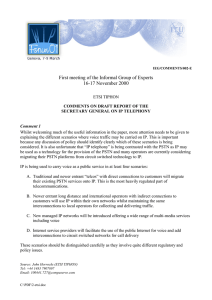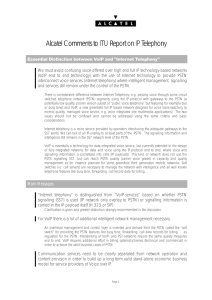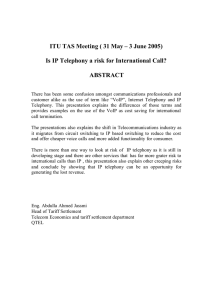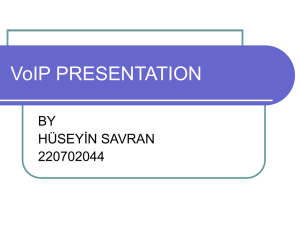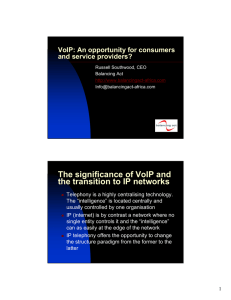Alcatel Comments to ITU Report on IP Telephony
advertisement
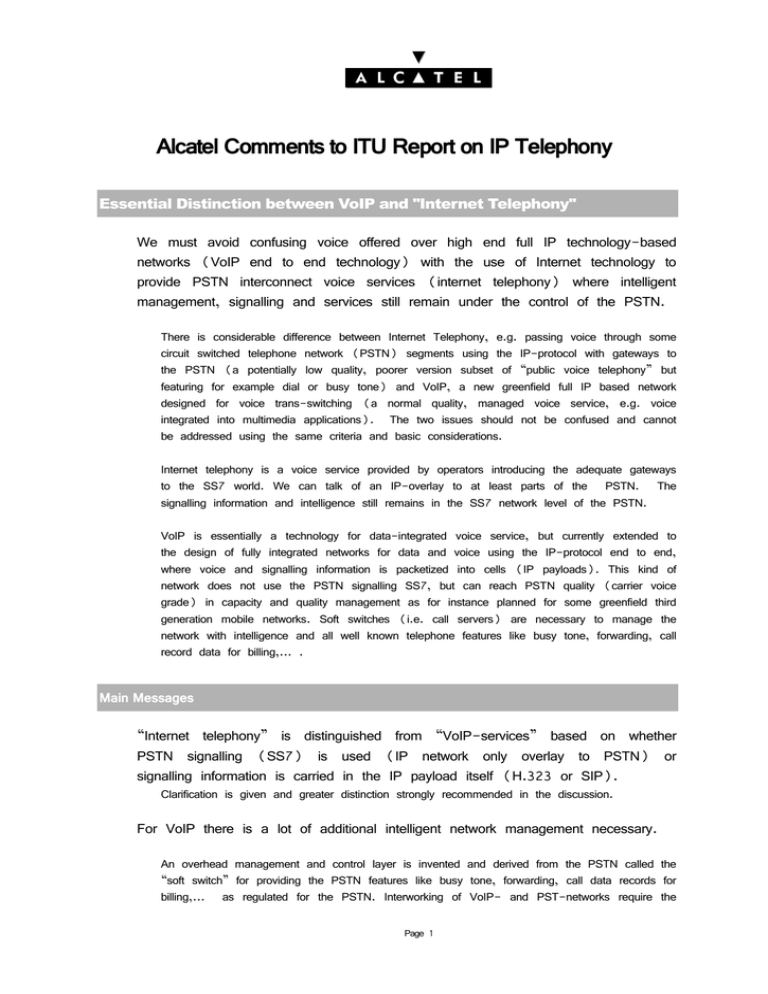
Alcatel Comments to ITU Report on IP Telephony Essential Distinction between VoIP and "Internet Telephony" We must avoid confusing voice offered over high end full IP technology-based networks (VoIP end to end technology) with the use of Internet technology to provide PSTN interconnect voice services (internet telephony) where intelligent management, signalling and services still remain under the control of the PSTN. There is considerable difference between Internet Telephony, e.g. passing voice through some circuit switched telephone network (PSTN) segments using the IP-protocol with gateways to the PSTN (a potentially low quality, poorer version subset of “public voice telephony” but featuring for example dial or busy tone) and VoIP, a new greenfield full IP based network designed for voice trans-switching (a normal quality, managed voice service, e.g. voice integrated into multimedia applications). The two issues should not be confused and cannot be addressed using the same criteria and basic considerations. Internet telephony is a voice service provided by operators introducing the adequate gateways to the SS7 world. We can talk of an IP-overlay to at least parts of the PSTN. The signalling information and intelligence still remains in the SS7 network level of the PSTN. VoIP is essentially a technology for data-integrated voice service, but currently extended to the design of fully integrated networks for data and voice using the IP-protocol end to end, where voice and signalling information is packetized into cells (IP payloads). This kind of network does not use the PSTN signalling SS7, but can reach PSTN quality (carrier voice grade) in capacity and quality management as for instance planned for some greenfield third generation mobile networks. Soft switches (i.e. call servers) are necessary to manage the network with intelligence and all well known telephone features like busy tone, forwarding, call record data for billing,... . Main Messages “Internet telephony” is distinguished from “VoIP-services” based on whether PSTN signalling (SS7) is used (IP network only overlay to PSTN) or signalling information is carried in the IP payload itself (H.323 or SIP). Clarification is given and greater distinction strongly recommended in the discussion. For VoIP there is a lot of additional intelligent network management necessary. An overhead management and control layer is invented and derived from the PSTN called the “soft switch” for providing the PSTN features like busy tone, forwarding, call data records for billing,... as regulated for the PSTN. Interworking of VoIP- and PST-networks require the Page 1 same quality measures end to end. VoIP requires additional effort in billing systems/schemes (technical and commercial) in order to achieve the valid business cases of PSTN. Communication services need to be clearly separated from network operation and content provision in order to build up a long term valid stand-alone economic business model for service providers of Voice over IP. Seamless services over broadband- and narrowband access systems require standardized interfaces for the aforementioned separation. Comments to SUMMARY Section of ITU Report The following should be put into perspective when discussing a future outlook: The forecast for much more than next 10 years switched networks still generate considerable revenues. demonstrates that circuit In 2000 $ 900 Mio sales will have been generated world-wide with IP-telephony according to a Frost & Sulivan study, increasing to $ 52,74 bn in 2005 and $ 91,49 bn in 2006. In 1999, the world-wide circuit switched PSTN including mobile generated 657 bn EUR sales and will increase to 766 bn EUR in 2001 according to the European Information Technology Observatory (EITO). Around 700 bn EUR sales of circuit switched network in 2000 represents nearly 700 times the sales in IP-telephony. For 2006 the IP-telephony is expected to represent 10% of circuit switched network sales due to an increase in 3rd generation mobile, but not in international calls Will the PSTN be fully replaced by IP substitution networks? This will probably not happen due to a saturation factor given by the most efficient network architecture for both real-time services (like voice and video) and delivery services (like data) with a certain time of delivery according to payment. In addition, legacy systems will remain active ensuring a reasonable return on invest (investment protection) for existing and new equipment as a prerequisite in business world and in order to fulfil the Universal Service Obligation with reasonable quality (under State responsibility). Technology evolution and changes to the general network are constant (IP today, newer versions of IP and other technologies tomorrow). The future converged networks might look like a mix of existing circuit switched networks with large central switching/management functions as well as distributed lower level switching nodes on local level with packet overlay whenever adequate and economical with regard to the actual voice/data relation. Page 2 This relation varies from network section to network section with impact on the optimized mix of overlay and merged networks. Standardization bodies have already demonstrated such converged networks for the third generation mobile networks (IMT2000) in an outstanding manner. In addition locally advanced full IP-networks are built for special purposes like private campus networks, data focussed public networks, nation-wide telematic systems... The “star”-structure of the PSTN is especially adapted for real-time services, which is still the future structure and a basis for all kinds of overlay networks. This is the only network really providing reasonable revenues while meeting endusers strong demand for high quality real-time voice telephony. In addition, it is the only network with a proper inbound region (SS7) where users cannot interfere without major attacks. To drop that and to switch completely over to VoIP, would make the world-wide telephone network even more sensitive to cybercrime. Related Questions What does ´Technology Neutral Regulation´ mean? A technology refers to equipment design based on technical specifications, usually standards (ISDN, IP, ATM, GSM are names of standardized technologies). A name of a technology should never appear in a service definition. Services must be defined by QoS, service level agreements (SLA) and end-user perception ONLY. Standards (from standardization bodies, or de facto) should never be referenced in regulation. Regulation must be based on generic market principles in order to be compliant with general competition law and related international agreements like the mutual recognition agreement (MRA). Voice related Internet and Questions for Transition? Transition from the existing PSTN legacy infrastructure and related revenue schemes to a more complex, converged infrastructure blurring communication services types and end-user applications is now under progress. The current legislation already considers IP-services as telecommunications services in nearly all countries of the world. Just some of the provisions are not applicable to Internet Service Providers not offering voice telephony for the public. Moreover, the newly drafted regulatory framework of the EC drops the outstanding character of voice telephony compared to data services, but not the rights and duties of licensed or at least notified operators of telecommunications infrastructure for the public. Thus PSTN Page 3 and VoIP services for the public will be technology neutral both considered as Voice Services under the category of communications services. There is no timeframe as integration and improvement is a constant driving factor in economic development. Legacy remains in operation for many reasons like investment protection, consumer protection, public interests, cultural aspects with strong impact on the content- and thus data traffic development... Analogue parts of the network are still built upon (e.g.: modem DSL solutions over existing copper access lines). The transition from narrow-band to broadband internet requires seamless service interoperability between both, requiring the mix of overlay and merged network architecture. Full-IP networks are considered as a kind of multiprotocol system with the unique internetworking protocol TCP/IP. The transition period for establishment of such complete IP based networks is estimated to be longer, in the case of integrating really all features, quality of service and uptime, we are used to in circuit switched networks. That requires an evolutionary approach fitting into the existing infrastructure in order to make The IP-revolution a real revolution with a valid business case when considering voice with the capability to reach every person of the world. Is IP Telephony an Application or a Service? For IP telephony a wide range of processes have to be provided by a service provider. Beside the transport and switching activities of an infrastructure provider the service provider has to care for subscriber management, call set up of sessions, re-routing, access to databases and Intelligent Network (IN) value added features,... . “IP telephony” is in fact a contradiction in terms: “IP” being a technology, “telephony” referring to a PSTN basic set of communications services. A legal regime has been defined in the new drafted regulatory framework directive of the EC for communications service providers dealing with for instance call set up services and all the aforementioned related issues. Voice telephony will disappear into a revenue-based “communication service” over any infrastructure. Page 4 This means, any IP-based voice should be possible e.g. a voice session inside a service package (access to call centre, session management, call set-up, routing services, soft switching) Voice or data are indifferent – indistinguishable inside a “same” communication service This brings us to the further question: - Will voice (access- and trans-switching) service be merged into the data service model and treated as an unpaid content or - will data (access- and trans-switching) service be merged into voice economic model with an adequate payment system for the service (time-, volume-, service-based billing including flat rates) ? The second option seems to offer the more stable business model, better adapted to what the users are ready to pay for ! How will Revenues be maintained in Telecommunications? A three tier revenue generation scheme has been reflected in the new regulatory framework directive drafted by the EC: content (highest level), service (communication/transport) and infrastructure (operations, interconnection) level with reasonable rights and duties in order to comply with the value chain by independent business models without cross subsidisation. Basic requirement should be to avoid any cross-subsidisation between revenue generating regimes. This will be achieved by : Building new communication service charging models using time-, volume- and servicedependent tariffing including flat rates as already applied in advanced combinations of GSM voice/SMS/e-commerce offers Content/Publicity revenues characterized by copyright transfer independent from communication/access service Content/Application revenues characterized by portal- and application software provision/licensing, authorized usage What is the Impact on the Telecom Value Chain and Business Model? End of cross subsidization implies the death of “free of charge” concept. Current time dependent tariffing model for voice will be extended to new applicationdependent offers for future multimedia sessions opening a large variety of new tariffing models. Page 5 The full IP-based model is not cheaper than the existing PSTN when comparing the number of subscribers, network management, directory/information services, QoS … This is often underestimated when saying that VoIP is cheaper than SS7 switched voice – this will change rapidly when cross- subsidization falls. What changes in Infrastructure Investment? The most obvious change in investment is characterized by shorter innovation cycles with strong demand on downwards compatibility of the equipment. Some network elements can be exchanged, others are operated for a certain time as overlay. The combination of circuit and packet switched sections required additional development of multi protocol elements, gateways and interfaces for shared use of different operators. New management systems play an increased role in integration of element managers of different suppliers. This trend has demonstrated to be a “must” in order to handle the hybrid network. Management system interfaces are currently defined and some have already been standardized. Open interfaces get more importance than in the past and are strongly requested by the operators. Very few high level management centers will control the network of a whole country with less operational staff. Future combined circuit and packet switched networks need a common control layer. The traditional circuit switches are thus split into transport and control layer, which is simultaneously used for the packed switched domain. The control layer is called “soft switch” allowing quick and easy exchange of transport elements according to the traffic demand. What changes in Peering Agreements (with the goal of adopting IP Access to the Reference Interconnection Offer (RIO) including commercial leverage scheme completing the peering agreement, like inter operator settlement rates) ? Due to the fact that business models consider interfaces as commercial interfaces legal protection is required. For example, in Europe peering will be redefined for that purpose under IP interconnection with a more open and transparent handling of the commercial interface. As soon as interfaces transfer money, clear rules in legislation are requested. Inter operator accounting systems get more sophisticated and automated. Gateways will carry commercial information with special request on accounting accuracy. High level billing systems have to collect and integrate a large variety of different record data (time-, volume-, service-data) as well as data from other service providers like e-commerce providers, telematic service providers,... To conclude, the term “IP telephony” should be discarded, the voice aspect (Internet telephony) disappearing into a technology neutral communication service in the EU´s legal context, VoIP being just one of the technologies enabling such service delivery. Page 6
